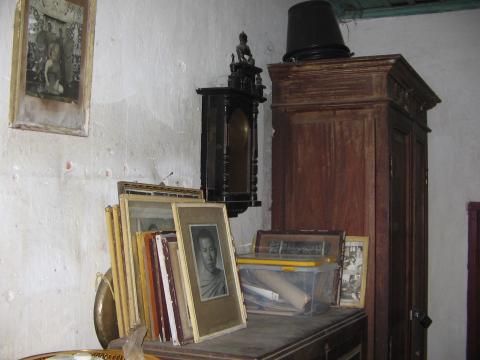
Aims and objectives
An EAP pilot project (EAP086) investigated the extent and conditions of an archive of Theravada Buddhist photographs now mainly preserved in one monastery of Luang Prabang/Laos, and started scanning and digitizing the material. The material found is of high scientific and documentary significance, and very rare. In more than 15,000 single photographs, it covers 120 years of Buddhist photography. The archive has escaped loss, dispersion and voluntary destruction that afflicted many historic collections of photography in South East Asia with the extraordinary political and social changes that afflicted the region in the 20th century, only because a highly venerated monk, Phra Khamchanh Virachittathera, who for more than 70 years has been a collector of photographic documents, found ways to astutely gather, protect and, for many years, hide the archive from outsider intrusion and inspection. With the loss of the photographic collections of the National Archive and the National Library of Laos during the revolutions of 1975, this surviving collection is of particular significance and importance.
The important and vulnerable archival material found in the monastery is highly endangered. Curiously, the fact that few people know about it, represents one of the biggest threats today: laypeople and monks of the monastery would not know how to deal with the material, and how to resist possible commercial interests towards the older photographs it contains. The way of keeping and stocking of the photographs at this moment does not respect normal archival standards; some photographs have been dramatically mishandled in the last years.
The pilot project EAP086 won the confidence of the abbot and his agreement for a complete digitisation of the material, and started systematic identification of single documents through interviews with him. A small local team of former monks has been formed to do this work. Part of the research project is to further train this local staff, and a group of selected students from the Buddhist Secondary School of Luang Prabang, in copying and preservation techniques - the first such teaching in Laos ever.
One of the urgencies for the research comes from the extraordinary chance to do these interviews. This is a unique moment to collect vital contextual information which it will not be possible to acquire in any subsequent occasion.
A particular quality of the material lies in the fact that it is a view from inside: all photographs seen so far were done by Buddhist people involved in the ritual life of the city, or even monks that worked as photographers, who documented their own world. The archive therefore contains a view totally different from the experience of western ethnographic photography of the past, or from photographic documentation of today, done by westerners.
The project will establish digital copies of all images in accordance with the EAP copying requirements and the original photographs (all highly vulnerable, and now often in dangerous conservatory conditions), will be relocated in the monastery, setting up a minimum of conservatory standards. Full digital copies of the archive will be established for the British Library and the National Library of Laos in the capital, Vientiane. The National Library has an ongoing commitment to make its archival material accessible to the Lao people, providing public access points for the viewing of digital data. A reference listing of the archive's images will be produced in Lao and English to facilitate access to the archive for local monastic and lay communities in Luang Prabang after the conclusion of the project.
Outcomes
15,000 original photographs have been secured, researched and digitised. Digital copies and listings prescribed by EAP listing guidelines have been created and deposited with the British Library and the National Library of Laos.
Originally starting from one large collection preserved in the monastery of Vat Saen Sukharam, assembled by Abbot Phra Khamchan Virachitta Maha Thera, (also named Phra Khamchan Virachitto), the grant discovered more collections in other monasteries of the town. Ten of these collections and one private collection were treated by the project. In addition, a much larger number of photographs and negatives was discovered and secured; they await identification and digitisation in the next EAP project.
A conservation report based on the situation of two collections was written at the beginning of the project in 2007 and forms part of the grant's outcome. Following the advice by the conservation expert, basic conservation work on the original photographs (removal from hazardous placement in frames or albums; safe storage in special cabinets) was carried out.
The grant led to the establishment of an archive of photography and to the formation of a team of monks, novices and former monks who were trained in digitisation, archiving practice and handling of photographic materials.
The original photographs are now mainly housed at the Buddhist Archive of Photography of the Sangha of Luang Prabang at Sala Thammaviharn, Vat Khili, Luang Prabang, a space created thanks to the activity of the EAP research team. Some collections have partially been given back to the respective monasteries. The private collection has been given back to the collector.
Access to the original photographs for research purposes will be granted following a written request, and presentation of a research outline, by the Buddhist Fellowship of the Sangha of the District of Luang Prabang.
The records copied by this project have been catalogued as:
- EAP177/1 Collection of photographs at Vat Saen Sukharam [1876-2008]
- EAP177/2 Collection of photographs at Vat Xiengthong [1951-2001]
- EAP177/3 Collection of photographs at Vat Suvanna Khili [1910-1987]
- EAP177/4 Collection of photographs at Vat Xieng Muan Vachiramangkhalaram [1920s-1996]
- EAP177/5 Collection of photographs at Vat Phou Khouay Phokharam [1926-2007]
- EAP177/6 Collection of photographs at Vat Pa Phon Phao [1940s-2004]
- EAP177/7 Collection of photographs at Maha On Si [1925-2003]
- EAP177/8 Collection of photographs at Vat Nong Sikhounmeuang [1940-1922]
- EAP177/9 Collection of photographs at Vat Pak Khan [1968-2007]
- EAP177/10 Collection of photographs at Vat Khom Khouang [1938-2006]



